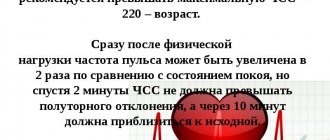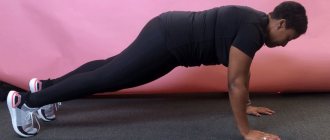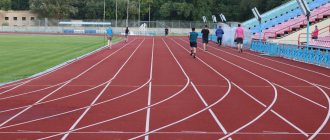Publication date: August 22, 2020.
Today running is fashionable! Everyone runs - short and long distances, go to marathons or go for a run at the neighboring stadium.
And this is understandable, because running is a simple, familiar and very natural exercise for our body.
It gives health, brings pleasure, gives a feeling of fullness of life, helps to feel strong, resilient, energetic, and improves immunity.
Running is not just an opportunity to show off on the treadmill, but also your chance to lose weight in the most harmonious way, providing the body with types of movements that are beneficial for it.
Today we will figure out how much you need to run and how to do it to lose weight.
The benefits of running for weight loss
In addition to losing weight, blood circulation improves while running, so it has a beneficial effect on the functioning of the cardiovascular system and normalizes blood pressure. In addition, the benefits of running include the following:
- strengthening the abdominal muscles, breathing, legs;
- increased appetite and restoration of digestion;
- normalization of blood sugar levels, which helps increase the number of red blood cells.
The benefits of running for men are expressed in its beneficial effect on potency. For women, this sport has a positive effect on the functioning of the endocrine system and stabilization of hormonal levels. The condition of the skin improves, the body becomes elastic and toned.
Special sports training
Great as an exercise to improve competitive fitness
This tempo workout is ideal for improving the ability to run again and again in short, sharp bursts, which is required in many team sports, including football and rugby.
- 5 minutes warm-up;
- 2 minutes running at moderate intensity, 2 minutes at low intensity;
- 30 seconds - with high intensity, 30 seconds - with low intensity (repeat three times);
- 10-second sprint, 90-second low jog (repeat six times);
- 30 seconds - with high intensity, 30 seconds - with low intensity (repeat three times);
- 2 minutes – with moderate intensity, 2 minutes – with low intensity;
- 10-second sprint, 90-second low jog (repeat six times);
- 5 minute cool down.
Recommendations
Numerous reviews indicate that running helps you quickly and effectively lose extra pounds, but only if you do it systematically. In order for the classes to be as useful as possible, you will have to adhere to certain recommendations:
- an hour before jogging you need to replenish your carbohydrate supply;
- It is not recommended to drink large amounts of water while running;
- while running, you should not stick to the count;
- It is advisable to avoid jogging on asphalt, since this involves excessive impact loading, which can lead to various injuries.
Before you start running, it is important to first review your own diet. It is advisable to give up alcohol, sweets, baked goods, fatty and fried foods. This will help you run more efficiently and lose weight faster.
On a note! If you run correctly, you can lose several kilograms in just a month and restore your health.
Joe Pavey's 10K Interval Training
Tough, but effective. That's how we would describe this interval training, pioneered by one of Britain's great athletes, Jo Pavey, who is currently preparing to compete in her sixth - yes, sixth - Olympics. Since Pavey is probably best known for running the 10,000m (having won the distance at the 2014 European Championships at the age of 40), we asked her for advice on how to train better. If you're planning a 10K race this year, add this workout to your plan.
“I really love interval training, where you have periods of multi-speed training,” Pavey says. “Some people like pyramid training: running 200, 400, 600 and 800 meters and then back down again. I used to do this when I was younger, but now I like to start with a long, intense run and then do short intervals. Otherwise, you will run 200m as fast as you can before doing anything else; You will waste your time on small things and will not be able to get the maximum benefit from your training. In fact, you won't be able to run as fast as you want or as fast as you could without putting in a lot of effort."
To prepare for a 10K, Pavey prefers to do what she describes as “really quality training” with longer repetitions. “Four or five 1000m reps, but with three minutes of recovery to really get the load I want.”
Shorter repetitions are then performed, decreasing accordingly with rest periods. “After that, I would take five or six minutes to recover and then do a block of eight 400m intervals, but with only 35 seconds of rest,” says Pavey. “I try to maintain the same or faster pace than at 1km intervals. Distance gives you the opportunity to really increase your speed, but then you have to maintain it in subsequent repetitions. I find it really useful."
This is followed by another five or six minute recovery, with some even shorter reps for the rest of the workout. “If everything is good, I do a couple of 200m intervals. And if everything is really good, I do two more 200m intervals, because if I feel like my sprinting is going well, I concentrate as much as possible on my running form and I’ll try to improve it.”
Running technique
To choose the right technique for yourself, it is advisable to try all types in advance, and then accurately determine the appropriate option. You should run so as not to get out of breath and not get tired. For beginners, it is advisable to start with minimal loads and then gradually increase it. You can use a standard program for beginner runners or develop your own training system.
Correct running technique:
- You need to run regularly, at least 2 times a week;
- First you need to run short distances, and then increase the distance;
- to avoid injuries and sprains, it is recommended to do a 10-minute warm-up before jogging, consisting of squats, lunges and other simple exercises;
- it is important to maintain correct posture while running;
- Always keep your legs bent at the knees;
- when running, you need to breathe regularly and calmly - if the brain is oversaturated with oxygen, dizziness may occur;
- It is not recommended to swing your arms strongly while running, but you also do not need to press them tightly to your body; they should be bent at the elbows at an angle of 110 degrees;
- You can breathe through your nose or mouth, it doesn’t matter;
- It is recommended to maintain a moderate running pace - it should be such that you can easily talk while jogging without getting out of breath;
- you should pay attention to your feet, avoid strong impacts of the heel on the ground, since in this case the load on the spine and knees significantly increases, it is advisable to transfer your body weight to your toes.
In addition to losing weight, proper running technique will help you enjoy the process itself.
On a note! To track the results achieved, novice athletes are recommended to create a special running table for weight loss, in which they need to enter certain data: body weight, nutrition, training frequency, distances covered, etc.
Categories and titles in athletics
Any ranks and titles can be obtained only by participating in competitions and fulfilling the standards established by the Russian Athletics Federation. Children under 18 years of age can only apply for youth categories. III category is assigned to athletes under the age of 14 years. From 14 to 16 years old you can go to II. And from 16 to 18 years old, receive the 1st youth category.
More significant sports titles are Candidate Master of Sports (CMS), Master of Sports (MS), International Master of Sports (MSMK) and Honored Master of Sports of Russia.
Titles, starting from “Master of Sports” and above, are awarded once for life. But athletes have to constantly confirm their ranks. “Candidate Master of Sports” is renewed every three years, and categories from 1 to 3 – every 2 years. To do this, you must either compete in competitions or pass standards.
By the way, it is quite possible for amateurs to obtain ranks in athletics up to Candidate Master of Sports. But, unfortunately, it is almost impossible for a running fan to “run” to “Master of Sports”. Although amateurs, just like professional athletes, need to confirm the rank they have received and pass the standards.
What does a running program for weight loss consist of?
Specialists have developed a special program, the data of which is entered into a table. It indicates how much running you need to lose weight and what types of training to use.
The training program combines regular and interval running, strength exercises and rest:
- running to break down fat - you will have to run for a certain time, maintaining a pace, the pulse should correspond to 65% of the highest frequency;
- strength exercises - the combination of running with strength exercises gives the highest results, these include squats, lunges, bench presses, deadlifts, push-ups;
- interval sprints - running on a steep climb or on a treadmill set at an incline of 6-8%;
- running at a measured pace - easy jogging for about 20 minutes;
- rest is a break necessary to restore the body.
Interval sprints are performed as follows. Initially, you need to run at an easy pace for about 10 minutes on a flat surface. After this, sprint up the slope at a fast pace for 30 seconds, and then run down the slope for 2 minutes. The number of sprints is shown in the table. At the end, you need to run again for 10 minutes at a light jog on a flat surface.
Instead of resting, you can devote time to regular walking.
Principles for creating your own training plan
The lesson plan is drawn up in accordance with personal anthropometric data and capabilities. The table shows the number of calories burned per 1 kg of body weight for different types of loads.
| Motor activity cal/h | Per 1 kg of weight | For 50 kg weight | For 80 kg weight |
| Running ( 9 km/h ) | 9,6 | 480 | 768 |
| Over rough terrain ( 8-9 km/h ) | 10,2 | 510 | 816 |
| Jogging ( 8 km/h ) | 8,3 | 415 | 664 |
| Race walking ( 6.5–7.5 km/h ) | 6,5 | 325 | 520 |
| Walking ( 6 km/h ) | 4,8 | 240 | 384 |
| Hiking ( 4 km/h ) | 3,2 | 160 | 256 |
| Walking ( 4.2 km/h ) | 3,1 | 155 | 248 |
Weekly chart for men
The program for beginner men with normal physical fitness is compiled for a week . After this time, it is adjusted depending on the results obtained.
| Day of the week | Warm-up | Main part | Final part |
| Monday | Warm up all muscle groups - 5 minutes , brisk walking - 10 minutes. | Running at an average pace - 20 minutes. | Running at a calm pace – 10 minutes , walking at a fast pace ( 5.5–6 km/hour ) – 10 minutes, cool-down – 5 minutes. |
| Tuesday | Warm up all muscle groups – 10 min . | Walking at a fast pace ( 5.5–6 km/hour ) – 30 minutes. | Cool down – stretching for all muscle groups. |
| Wednesday | Warm up all muscle groups - 5 minutes, brisk walking - 10 minutes. | Interval running – 20 min. Fast – 3 minutes , moderate – 2 minutes. | Walking at a fast pace ( 5.5–6 km/hour ) – 10 minutes , cool-down – 5 minutes. |
| Thursday | Warm up all muscle groups – 10 min . | Walking at a fast pace ( 5.5–6 km/hour ) – 30 minutes. | Cool down – stretching for all muscle groups. |
| Friday | Warm up all muscle groups - 5 minutes, brisk walking - 10 minutes. | Running at a moderate pace over rough terrain – 30 minutes. | Calm walking – 10 minutes , alternating with stretching exercises. |
| Saturday Sunday | Rest | Walking at a speed of 5-6 km/h – 30-40 minutes. | Cool down – stretching for all muscle groups. |
Long-term program for 8 weeks for women
For women, the best results in the fight against fat will bring interval sprints lasting 8 weeks . An example program looks like this:
| Day Week | Monday | Wednesday | Tuesday Thursday and Sunday | Friday | Saturday |
| 1 | Cycle 10 times Running 1 Walking 2 | Cycle 10 times Running 1 Walking 2 | Rest | Cycle 10 times Running 1 Walking 2 | Cycle 10 times Running 1 Walking 2 |
| 2 | Cycle 10 times Running 2 Walking 1 | Cycle 7 times Running 3 Walking 1 | Rest | Cycle 6 times Running 4 Walking 1 | Cycle 6 times Running 4 Walking 1 |
| 3 | Cycle 5 times Running 5 Walking 1 | Cycle 5 times Running 5 Walking 1 | Rest | Cycle 4 times Running 6 Walking 1 | Cycle 4 times Running 6 Walking 1 |
| 4 | Cycle 3 times Running 8 Walking 1 | Cycle 3 times Running 9 Walking 1 | Rest | Cycle 2 times Running 10 Walking 1 after cycle Running 8 | Cycle 2 times Running 11 Walking 1 after cycle Running 6 |
| 5 | Cycle 2 times Running 11 Walking 1 after cycle Running 4 | Cycle 2 times Running 13 Walking 1 after cycle Running 2 | Rest | Cycle 2 times Running 14 Walking 1 | Run 15 Walk 1 Run 14 |
| 6 | Cycle 16 times Run 1 Walk 13 | Run 17 Walk 1 Run 12 | Rest | Run 18 Walk 1 Run 11 | Run 19 Walk 1 Run 10 |
| 7 | Cycle 20 times Running 1 Walking 9 | Run 12 Walk 1 Run 7 | Rest | Run 24 < Walk 1 Run 5 | Run 26 Walk 1 Run 3 Rest |
| 8 | Cycle 27 times Running 1 Walking 2 | Running 28 Walking 1 Running 1 | Rest | Running 29 Walking 1 | Run 30. Goal achieved! |
*In the table, all intervals are indicated in minutes.
Running chart for weight loss for men and women
How to effectively use running for weight loss, how much you need to run, how to distribute the load correctly - a special table has been compiled for this. The duration of the training program is 8 weeks, after which you can get visible results.
Below is a table of running for weight loss.
| A week | Monday | Tuesday | Wednesday | Thursday | Friday | Saturday | Sunday |
| 1 | Running to burn fat (30 minutes) | Strength exercises (15 minutes) | Hill interval sprints (6 sprints) | Rest | Strength exercises (15 minutes) | Running to break down fats (45 minutes). | Rest |
| 2 | Running to burn fat (35 minutes) | Strength exercises (30 minutes) | Hill interval sprints (7 sprints) | Rest | Strength exercises (30 minutes) | Running to burn fat (50 minutes). | Rest |
| 3 | Running to burn fat (40 minutes) | Strength exercises (30 minutes) | Hill interval sprints (8 sprints) | Rest | Strength exercises (30 minutes) | Running to burn fat (55 minutes). | Rest |
| 4 | Running to burn fat (30 minutes) | Strength exercises (15 minutes) | Hill interval sprints (6 sprints) | Rest | Strength exercises (15 minutes) | Running to break down fats (45 minutes). | Rest |
| 5 | Running to burn fat (45 minutes) | Strength exercises (45 minutes) | Hill interval sprints (9 sprints) | Rest | Strength exercises (30 minutes) | Running to burn fat (60 minutes). | Rest |
| 6 | Running to burn fat (50 minutes) | Strength exercises (45 minutes) | Hill interval sprints (10 sprints) | Rest | Strength exercises (45 minutes) | Running to burn fat (65 minutes). | Rest |
| 7 | Running to burn fat (40 minutes) | Strength exercises (30 minutes) | Hill interval sprints (7 sprints) | Rest | Strength exercises (30 minutes) | Running to burn fat (50 minutes). | Rest |
| 8 | Running to burn fat (55 minutes) | Strength exercises (45 minutes) | Hill interval sprints (12 sprints) | Rest | Strength exercises (45 minutes) | Running to burn fat (70 minutes). | Rest |
Pyramid training
Great for fat burning and weight loss.
Pyramid training involves gradually increasing the duration of running at a high intensity until a maximum is reached, and then decreasing it.
- 5 minutes warm-up;
- 30 seconds running at high intensity, 60 seconds at low intensity;
- 45 seconds – with high intensity, 60 seconds – with low intensity;
- 60 seconds - with high intensity, 60 seconds - with low intensity;
- 90 seconds – with high intensity, 60 seconds – with low intensity;
- 60 seconds - with high intensity, 60 seconds - with low intensity;
- 45 seconds – with high intensity, 60 seconds – with low intensity;
- 30 seconds - with high intensity, 60 seconds - with low intensity;
- 5 minute cool down.
How to calculate running efficiency based on heart rate?
It is believed that the average time spent running should be about 40 minutes. But beginners can first exercise for 15 minutes, gradually increasing the load. Experienced runners say that it is not so important how to start running as its continuation and completion. To keep your body in perfect shape, you will need to spend at least 100 minutes jogging a week.
The main role is played by the correctly chosen pace, which determines the pulse rate. Calculation of the individual load on the body while running is carried out in the following way:
- subtract your age from 220;
- subtract 50% from the obtained value;
- a normal pulse was obtained.
During running, the heart rate should slightly exceed the obtained value.
Algorithm for determining the IPC from a book
- Find the VDOT value (Jack Daniels refers to it as VDOT, indicating by its other name that it is a calculated value, “pseudo-VO2”) that corresponds to your competition results in the “VDOT Values for Competition Results” table. For example, let's say you ran 5,000 meters in a race in 22 minutes. The closest MIC to this value is 44. In addition, you finished the half marathon in 1:45:02 - this corresponds to an MOC = 43. As a result, you have two values (there can be as many of them as the distances you have completed in competition mode ; some may coincide).
- Select the highest VDOT value obtained. In our example, this is max {43, 44} = 44. This is the value you will use to calculate your training pace.
- You can predict your result in competitions using the obtained value. For example, if you set your VO2 max = 44 and have no marathon experience, you can expect to run a marathon in 3:32:23 (corresponding to VDOT = 44) with the proper training volume.
Interval training Fartlek
Great for adding variety to your regular runs
Fartlek means "speed game" in Swedish. Unlike other forms of interval training, which have a predetermined time frame, in Fartlek training you run at different intensities for different periods of time. This forces the body to guess what will happen next, forcing the heart, lungs and muscles to work harder and leading to improved fitness.
Warm up for 5 minutes... and then act according to the circumstances. If you spot a lamppost, tree or another runner in the distance ahead, run at high speed until you reach them, then slow down to recover. Then find another landmark and run towards it quickly. The beauty of Fartlek workouts is that you can make them as difficult or easy as you like. This makes the usual running pattern a little more useful.
Why is training not interesting to everyone?
If you ask a friend why he doesn’t train, you’re unlikely to hear anything concrete. Working out is an optional part of everyday life. While nutrition and sleep are vital, running is not.
Many people want to start training, but prefer to train with a company that they cannot find. Someone needs to be forced. There are those who do not see the need to start training. Also the reason is high employment, lack of free time and energy.
However, it is worth remembering that by training endurance, we get additional energy! An experienced runner stays awake for 24 hours, and once he also didn’t have enough strength to get up to his floor if the elevator broke down.
The presented running training program will help you gain endurance and resist fatigue at the frantic pace that modern life sets. Remember that running should become a habit, and any habit requires regular repetition!
How to gradually increase the load
Endurance is the ability to withstand loads for a long time without fatigue. It is the foundation of training.
Endurance training consists of:
- cardio training, first of all;
- building muscle strength;
- psychological readiness for long hours of stress.
The basic method for all this is long running workouts lasting more than 1.5 hours, but no more than 3-4.
In the plan, they should be present once every 2-3 weeks, with a gradual increase in time, distance and complexity. At the initial stages of preparation, long-term training is carried out in any conditions. Closer to the target start, they move closer to the “combat” start - ideally, along the race track.
The intensity of the load during long-term running training is low, the average heart rate is 110-140 beats/min.
Strength is the ability to overcome external resistance through muscle effort. It is often overlooked by recreational runners. Without sufficient strength training, it is impossible to develop running technique and strength endurance. Otherwise, injuries cannot be avoided.











